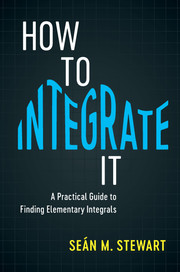Book contents
- Frontmatter
- Contents
- Preface
- 1 The Riemann Integral
- 2 Basic Properties of the Definite Integral: Part I
- 3 Some Basic Standard Forms
- 4 Basic Properties of the Definite Integral: Part II
- 5 Standard Forms
- 6 Integration by Substitution
- 7 Integration by Parts
- 8 Trigonometric Integrals
- 9 Hyperbolic Integrals
- 10 Trigonometric and Hyperbolic Substitutions
- 11 Integrating Rational Functions by Partial Fraction Decomposition
- 12 Six Useful Integrals
- 13 Inverse Hyperbolic Functions and Integrals Leading to Them
- 14 Tangent Half-Angle Substitution
- 15 Further Trigonometric Integrals
- 16 Further Properties for Definite Integrals
- 17 Integrating Inverse Functions
- 18 Reduction Formulae
- 19 Some Other Special Techniques and Substitutions
- 20 Improper Integrals
- 21 Two Important Improper Integrals
- Appendix A Partial Fractions
- Appendix B Answers to Selected Exercises
- Index
13 - Inverse Hyperbolic Functions and Integrals Leading to Them
Published online by Cambridge University Press: 11 December 2017
- Frontmatter
- Contents
- Preface
- 1 The Riemann Integral
- 2 Basic Properties of the Definite Integral: Part I
- 3 Some Basic Standard Forms
- 4 Basic Properties of the Definite Integral: Part II
- 5 Standard Forms
- 6 Integration by Substitution
- 7 Integration by Parts
- 8 Trigonometric Integrals
- 9 Hyperbolic Integrals
- 10 Trigonometric and Hyperbolic Substitutions
- 11 Integrating Rational Functions by Partial Fraction Decomposition
- 12 Six Useful Integrals
- 13 Inverse Hyperbolic Functions and Integrals Leading to Them
- 14 Tangent Half-Angle Substitution
- 15 Further Trigonometric Integrals
- 16 Further Properties for Definite Integrals
- 17 Integrating Inverse Functions
- 18 Reduction Formulae
- 19 Some Other Special Techniques and Substitutions
- 20 Improper Integrals
- 21 Two Important Improper Integrals
- Appendix A Partial Fractions
- Appendix B Answers to Selected Exercises
- Index
Summary
Common integration is only the memory of differentiation…the different artifices by which integration is effected, are changes, not from the known to the unknown, but from forms in which memory will not serve us to those in which it will.
— Augustus de MorganIn this chapter the inverse hyperbolic functions are briefly reviewed before various standard types of integrals that lead to inverse hyperbolic functions are considered.
§ The Inverse Hyperbolic Functions
From Chapter 9 you may recall that since the functions sinh and tanh are both increasing functions on their domain, both are one-to-one functions and accordingly will have well-defined inverses. Those inverses are denoted by sinh-1 x and tanh-1 x, respectively. The function cosh, however, is not one-to-one on its domain. To obtain an inverse its domain must be restricted. By convention the domain of the hyperbolic cosine function is restricted to the interval.
Since the hyperbolic functions are defined in terms of the exponential function, one would expect it would be possible to write each of the inverse hyperbolic functions in terms of the logarithmic function, the logarithmic function being the inverse of the exponential function. This is indeed possible. For example, to find an expression for the inverse hyperbolic sine function in terms of the logarithmic function, set y = sinh-1 x, then sinh y = x, or
After multiplying throughout by 2ey and rearranging, the following equation results:
which is quadratic in ey. On applying the quadratic formula, solving for ey gives
Here, since ey 0, the positive square root is taken. Taking the natural logarithm of both sides of the equation gives
Inverses for the other five hyperbolic functions can be found in a similar manner. These, together with each function's associated domain and range, are summarised in Table 13.1. In the table, where a plus and minus sign appear, the positive sign is used for x > 0, while the negative sign is used for x < 0.
Graphs for all six inverse hyperbolic functions are shown in Figure 13.1. Since the inverse hyperbolic functions can be expressed in terms of logarithms, their derivatives can be readily found.
Information
- Type
- Chapter
- Information
- How to Integrate ItA Practical Guide to Finding Elementary Integrals, pp. 169 - 177Publisher: Cambridge University PressPrint publication year: 2017
